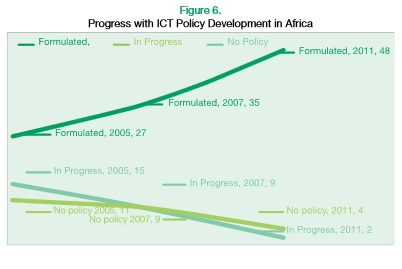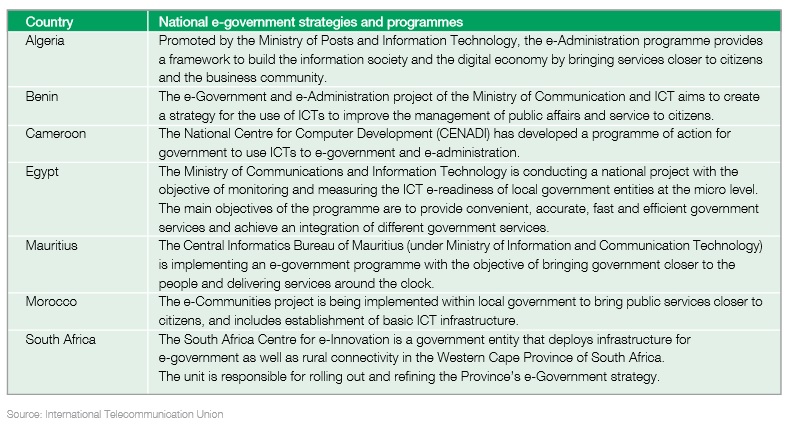Strengthening Africa’s ICT ecosystem means analyzing results and adjusting goals
A recap of ICT ecosystem goals set at the Connect Africa Summit held in October 2007 (in attendance were hundreds of participants from forty-three African countries) provides interesting commentary on how far African ICT has progressed in six years. Much has improved in terms of broadband access and policy, for example, but the level of development has fallen short of what stakeholders hoped for six years ago. Connectivity, universal access, policy, ICT skills, and e-applications take time to improve even when resources are focused.
The 87-page Connecting Africa Main Report, launched by AfDB during the Transform Africa 2013 summit (held in Kigali, Rwanda), assesses the goals set in 2007 and provides an updated outlook for African ICT development. Most often, goals have been pushed back by three years and additional means of reaching these goals have been added.
Analysis six years later finds that half of African countries have developed their broadband networks. Major cities and town are undeniably better connected. Still, most areas need national broadband strategies to guide infrastructure development. Villages remain under-served and provide little economic incentive to provide broadband access before at least 2015. Regulatory environments have been even slower to change due to increased complexity brought on by the convergence of technologies. Indigenous business models are needed as are cohesive regional policies. Progress in ICT skills development is sub-par as well. ICT projects cannot be successfully realized without awareness of ICTs and a core group of advanced IT professionals. Finally, the African Development Bank needs to play an even stronger role in meeting the aforementioned goals by stimulating public-private partnerships that focus on national broadband projects, by supporting policy advances, and by developing ICT skills training.
Below, we’ve summarized the key ICT goals and how to best achieve them, along with supporting facts mentioned in the report.
Strengthen broadband infrastructure within major cities
- The percentage of mobile broadband subscribers grew from 0.35% in 2007 to 3.8% in 2011. For reference, Europe had a 14 times higher rate of mobile broadband use in 2011.
- The number of African broadband subscribers is expected to grow from 30 million in 2011 to more than 200 million by 2015.
- The amount of international connectivity has skyrocketed for East Africa but it is not competitively priced.
- More than 80% of the African population is unable to connect to the internet.
- More than 30 countries lack sufficient national fibre backbone.
- Sudan has 22,000km of fibre cable, coming at a cost of US$6 billion. There are landing stations for four undersea cables.
- Gabon has two international fibre landing points (SAT3 and ACE). A World Bank project will contribute to the development of a national backbone. Separately, 200 engineers will be hired and trained to support infrastructure development. Telecentres in villages were built by the government to provide internet access. A tech park, Mandji Island Cybercity, will be built in Port Gentil.
- Solutions include better regulatory framework for regional interconnection, open access approaches, regional projects, PPPs, and services that stimulate network usage.
Connect villages to broadband
- Overall achievement of the goal is around 30%. That is, roughly 30% of rural areas have mobile coverage.
- Mobile voice coverage has improved from 65% in 2007 to 95% in 2011.
- Universal access funds exist in a handful of countries.
- Tunisia has 117% mobile penetration and 15% penetration of computers. A national fibre backbone is in place, with redundancy too. An IXP (TunIXP) exists as well. ADSL coverage is better than in most African countries. Fixed broadband penetrate was around 5% by the end of 2011. The Telecommunication Code specifies how to provide universal broadband service.
- A lack of private sector funding to bring broadband to rural areas means that economically unattractive areas still lack connectivity.
Have regulatory measures to promote affordable broadband access
- 40 African countries had an independent telecoms regulator at the end of 2011 (up from 38 in 2007).
- Many frameworks cover voice or television networks but lack attention on broadband.
- Regional regulatory harmonization efforts have been seen from EAC, ECOWAS, SADC, and AMU.
- Mali’s National Information and Communication Infrastructure Plan was begun in 2002, finalized in 2004, and approved in 2005. An action plan to implement the plan was approved in 2007. Although the government is on the right track with regard to policy development, it lacks financial means to implement the action plan that is now six years old.
- The creation of a Nigerian Ministry of Communication Technology in 2011 has led to the consolidation of ICT activities.
- Mauritius’ ICT policy targets increasing PC ownership by at least 20,000 households and 12,000 primary schools along with an increase in broadband penetration by at least 250,000 households.
- There is a need to open market segments to competition and update licensing and spectrum management practices in order to foster growth in broadband networks. The regulatory environment needs to remain innovative to handle the wide ICT ecosystem (ie. handle disputes and maintain IP rights).
- Ethiopia and Eritrea still have no mobile competition.
Develop a critical mass of ICT skills through the creation of training centers
- The skills needed to develop large-scale e-projects are still lacking even though many countries have established academic institutions to provide degrees in computing and networking.
- Almost all African countries have at least one Cisco academy that provides certification in certain networking technologies.
- Angola, Cape Verde, Equatorial Guinea, Guinea Bissau, and Mozambique are recipients of a Government of Spain and Government of Portugal project to create ICT centers of excellence (CoE).
- The African Development Bank is funding CoE in Mali, Rwanda, and Tunisia.
- Carnegie Mellon University in Rwanda, Kigali Institute of Technology, National University of Rwanda, and Integrated Polytechnic Regional Centre offer vocational training and ICT research.
- In Uganda, The National Information Technology Authority (NITA) was established with the mandate to coordinate, promote and monitor information technology development.
- More centers are needed to carry out research on policies, regulations, and e-applications.
Have a national e-strategy and multiple e-government services in each African country by 2015
- By 2011, 48 countries had developed a national ICT strategy. Only 32 had as of 2007.
- Although many policies have been developed, a lack of resources has led to relatively few implementations. A large number of plans have not been updated in upwards of ten years.
- Malawi has connected key government offices in Lilongwe using VSAT.
- EAC states all have e-governance as a key focus area of ICT policy.
- South Africa laid a vision for e-government in 2001 but the plan was not realized. Vision 2014 will address e-governance in some form.
- In 2007 the Kenyan government began an e-services delivery project with five key components.
- Countries like Cote d’Ivoire, Egypt, Kenya, Mauritius, Morocco, South Africa, Sudan, and Tunisia have established Computer Emergency Response Teams to monitor cyber security vulnerabilities.
Source: “Connecting Africa: An Assessment of Progress Towards the Connect Africa Summit Goals,” African Development Bank, May/Sept. 2013.















 Twitter
Twitter Facebook
Facebook Pinterest
Pinterest
[…] The 87-page Connecting Africa Main Report, launched by AfDB during the Transform Africa 2013 summit (held in Kigali, Rwanda), assesses the goals set in 2007 and provides an updated outlook for African ICT development. Most often, goals have been pushed back by three years and additional means of reaching these goals have been added. read more […]